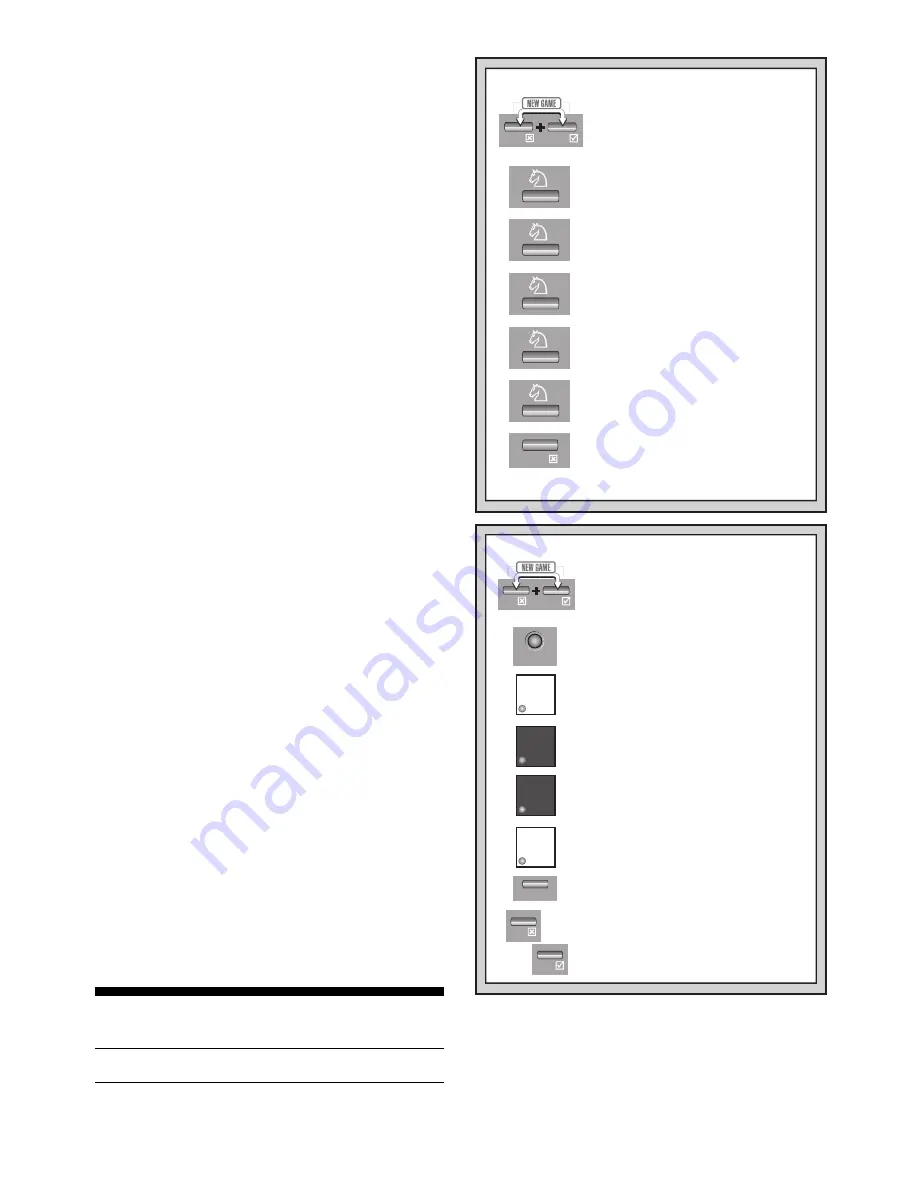
12
making. Press the FWD key repeatedly to see the rest of the
moves in this line of play, as noted below. The principal
variation is shown to a maximum depth of four ply, or four
individual moves. The BACK key can be used to back up
and see previous displays again.
• Predicted line of play: 1st move.
• Predicted line of play: 2nd move.
• Predicted line of play: 3rd move.
• Predicted line of play: 4th move.
Since the first move of the predicted line of play is the
move the computer assumes you will make, you can also
consider this move as a hint! So—whenever you need help,
press HINT/INFO on your turn! For details, see Section 2.5.
6.2 Search Information
Press HINT/INFO a second time to get information on
the computer’s search. Use the FWD key to cycle through
the four displays listed below. The BACK key can be used to
back up and see previous displays again.
• Numerical evaluation of the current position, based on a
pawn being worth 1.0 points. A positive number indicates
that White is ahead.
Note that this score is not valid on
the Problem Solving Levels or Tactical Levels, since a
different search method is used.
• Two numbers. The first is the current search depth, or
the number of individual moves the computer is looking
ahead. The second is the number of moves the com-
puter has examined so far.
• The move currently being evaluated.
• The search speed, or number of positions (nodes) being
searched every second. Watch as this number changes!
6.3 Chess Clocks
Press HINT/INFO a third time to gain access to chess
clock information. Use the FWD key to cycle through all the
clock displays, as described below. The BACK key can be
used to back up and see previous displays again.
• Time since the last move was executed.
• Total elapsed time for White.
• Total elapsed time for Black.
• Remaining time for White
(Speed Chess/Tournament
Levels only).
• Remaining time for Black
(Speed Chess/Tournament
Levels only).
The chess clocks keep track of the time for both sides.
The clocks stop whenever you take back a move, check
level settings, select options, verify or set up a position, or
turn the computer off. In all of these cases, however, the
times are retained in memory, and the clocks resume as
soon as play is continued. Whenever you change the playing
level or press YES/
?
?
?
?
?
and NO/X together to reset the com-
puter for a new game, the chess clocks are always reset to
0:00:00
.
6.4 Move Count/Game Moves
Press HINT/INFO a fourth time to show the move num-
ber in the game so far. You can then use the BACK key to
cycle back through the moves of your game (up to 64 indi-
vidual moves). The FWD key can also be used to go forward
again at any point and see all the moves. This gives you an
opportunity to go back and write down the moves (up to the
last 64 individual moves) of a game that turns out to be
unexpectedly great!
• Move number in game so far.
• Moves of the current game.
7. VERIFYING/SETTING UP POSITIONS
7.1 Verifying Positions
See “IT’S EASY TO VERIFY PIECES!” for a step-by-
step example of using Verify Mode.
If you should knock over the chess pieces or if you think
your board position may be incorrect, the computer can
verify all piece locations for you.
When it is your turn, press one of the Piece Symbol Keys
(
!
,
@
,
#
,
$
,
%
, or
&
). The computer says the name of the
piece, and uses board lights and the display to show you
where the first piece of that type is located. The display
shows the piece, color, and square location, and the light
turns on for that square. Press the same Piece Symbol Key
again to see the location of the next piece of that same type.
All the White pieces are shown first, then the Black pieces.
NO/
YES/
POSITION
NO/
YES/
WHITE
e2
e3
d8
h5
1. Press NO/X and YES/
?
together to
reset the computer for a new game.
Display:
0:00:00
.
TRY OUT POSITION MODE!
2. Press POSITION to enter Position
Mode. Display:
-POS-
.
3. Press the White pawn down on
Square e2, and remove it from the
board. Display:
[!-E2
.
4. Press that same pawn down on
Square e3 to add it to the board.
Display:
[!+E3
.
5. Press the Black Queen down on
Square d8, and remove it from the
board. Display:
]%-D8
.
6. Press that same Queen down on
Square h5 to add it to the board.
Display:
]%+H5
.
7. Press WHITE to change the color to
move next.
8. Press NO/X to exit; then press YES/
?
to confirm your new position and
return to game play.
For more details, see Section 7.2.
NO /
NO/
YES/
1. Press NO/X and YES/
?
together to
reset the computer for a new game.
Display:
0:00:00
.
IT’S EASY TO VERIFY PIECES!
2. Press KNIGHT.
Display:
[@b1
(1st White Knight).
Square b1 lights up.
3. Press KNIGHT again.
Display:
[@G1
(2nd White Knight).
Square g1 lights up.
4. Press KNIGHT again.
Display:
]@b8
(1st Black Knight).
Square b8 lights up.
5. Press KNIGHT again.
Display:
]@g8
(2nd Black Knight).
Square g8 lights up.
7. Repeat the above for any piece you
want to verify! Press NO/X to exit
Verify Mode.
6. Press KNIGHT again.
Display:
@
(no more Knights left on
the board).
For more details, see Section 7.1.














